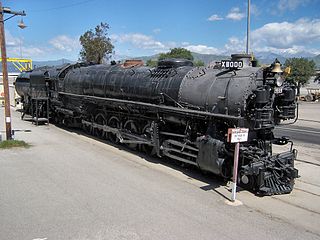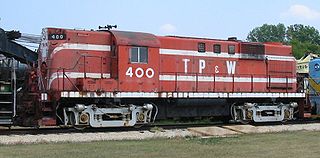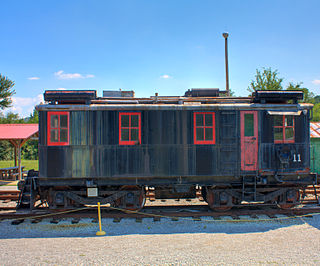
The ALCO HH series were an early series of switcher diesel-electric locomotives built by the American Locomotive Company (ALCO) of Schenectady, New York between 1931 and 1940, when they were replaced by the S series; the 660 hp (490 kW) S-1 and 1,000 hp (750 kW) S-2. They were ALCO's first diesel switchers to enter true series production, and among the very first land vehicles anywhere to use the revolutionary diesel-electric power transmission.

The ALCO PA was a family of A1A-A1A diesel locomotives built to haul passenger trains. The locomotives were built in Schenectady, New York, in the United States by a partnership of the American Locomotive Company (ALCO) and General Electric (GE) between June, 1946 and December, 1953. They were of a cab unit design, and both cab-equipped lead A unit PA and cabless booster B unit PB models were built.

Under the Whyte notation for the classification of steam locomotives, 4-12-2 represents the wheel arrangement of four leading wheels, twelve coupled driving wheels, and two trailing wheels. This arrangement was named the Union Pacific type, after the only railroad to use it.
Electro-Motive Diesel (EMD) is an American manufacturer of diesel-electric locomotives, locomotive products and diesel engines for the rail industry. The company is owned by Caterpillar through its subsidiary Progress Rail Services.

The ALCO RS-11 is a diesel-electric locomotive of the road switcher type rated at 1,800 hp (1.34 MW), that rode on two-axle trucks, having a B-B wheel arrangement. This model was built by both Alco and Montreal Locomotive Works. Total production was 431 units.

The ALCO RSD-1 was a diesel-electric locomotive built by American Locomotive Company (ALCO). This model was a road switcher type rated at 1,000 horsepower (750 kW) and rode on three-axle trucks, having a C-C wheel arrangement. It was often used in much the same manner as its four-axle counterpart, the ALCO RS-1, though the six-motor design allowed better tractive effort at lower speeds, as well as a lower weight-per-axle. It was developed to meet the need to supply the Soviet Union over the Trans-Iranian Railway starting in mid 1943. On the other hand, due to the traction generator and appurtenant control apparatus being sized for four axles and yet having two additional powered axles, it had poorer performance at higher speeds.

The ALCO boxcabs were diesel-electric switcher locomotives, otherwise known as AGEIR boxcabs as a contraction of the names of the builders. Produced by a partnership of three companies, ALCO built the chassis and running gear, General Electric the generator, motors and controls, and Ingersoll Rand the diesel engine. The principle of operation was the same as modern locomotives, the diesel engine driving a main generator of 600 volts DC with four traction motors, one per axle.

The ALCO FA was a family of B-B diesel locomotives designed to haul freight trains. The locomotives were built by a partnership of ALCO and General Electric in Schenectady, New York, between January 1946 and May 1959. They were of a cab unit design, and both cab-equipped lead FA and cabless booster FB models were built. A dual passenger-freight version, the FPA/FPB, was also offered. It was equipped with a steam generator for heating passenger cars.

The ALCO 300 was an early diesel-electric switcher locomotive built by the American Locomotive Company (ALCO) of Schenectady, New York between 1931 and 1938.

The Alco 539T was a diesel prime mover built by the American Locomotive Company. This engine was also used as a stationary powerplant, used in pipeline pumping stations, tugboats and dredges. It has a straight-six, four-stroke design in a cast block which produced from 810 to 1,000 horsepower. The engine has a bore of 12.5 inches (318 mm), and a stroke of 13 inches (330 mm). The 539 engine was built at Alco's Auburn, New York engine plant and later starting in September 1949 in Canada. The 539T was equipped with the Buchi turbocharger, being made under license by the Elliott Manufacturing Company of Jeannette, Pennsylvania. The first 539T engines were used in S-2 switchers and DL-105 passenger locomotives built in September 1940. Alco locomotives using this engine include the S-2, S-4, RS-1, RSC-1, RSD-1, DL-105, DL-107, DL-108, DL-109, and DL-110. MLW locomotives using this engine include the S-2, S-4, S-7, S-12, RS-1, and RSC-13.

The Gulf, Mobile and Northern Railroad Rebels were lightweight, streamlined diesel-electric trains built by American Car and Foundry. The first two trains, purchased in 1935, provided service between New Orleans, Louisiana and Jackson, Tennessee, approximately 450 miles (720 km) The third train, purchased in 1937, allowed service to be added between Jackson, Tennessee, and Mobile, Alabama. Unlike other earlier Diesel streamliners, these trains were not articulated, as their normal operation required adding and removing cars from the consist.
The Alco 251 is a 4-stroke diesel engine that was developed by the American Locomotive Company to replace the 244 and 539 engines. The 251 was developed to be used in diesel locomotives, as a marine power plant in ships and as a stationary power generator.

The South African Railways Class 15CA 4-8-2 of 1926 was a steam locomotive.

The GE boxcabs, sometimes also GE IR boxcabs, were diesel-electric switcher locomotives succeeding the ALCO boxcabs. The locomotives were built by General Electric and Ingersoll Rand without ALCO. Production lasted from 1928 till 1930. These boxcabs were often termed oil-electrics to avoid the use of the German name Diesel, unpopular after World War I.

The South African Railways Class 10D 4-6-2 of 1910 was a steam locomotive from the pre-Union era in Transvaal.
Perry T. Egbert was an American engineer specializing in internal combustion engines, particularly diesel engines. Most of his career was spent at the American Locomotive Company (ALCo), America's pre-eminent manufacturer of steam and diesel locomotives for more than forty years.
The ALCO 244 was a diesel prime mover built by the American Locomotive Company (ALCO). An evolution of the earlier 241 diesel engine, it powered ALCO's first generation of production road locomotives. The 244 engine was developed to create an engine capable of being used in railroad freight and passenger locomotives. The 244 engine was also used in a very limited basis as a marine power plant in ships and as a stationary power generator.
The Pennsylvania Railroad's class K29s comprised 1 experimental 4-6-2 "Pacific" type steam locomotive. Constructed by Alco-Schenectady, it was given road number 3395. Although only one demonstrator was constructed, the K29s would become the basis for the highly successful K4s Pacifics and L1s Mikados. The lone example spent most of its life on the PRR's Pittsburgh division main line and was retired around 1929.















